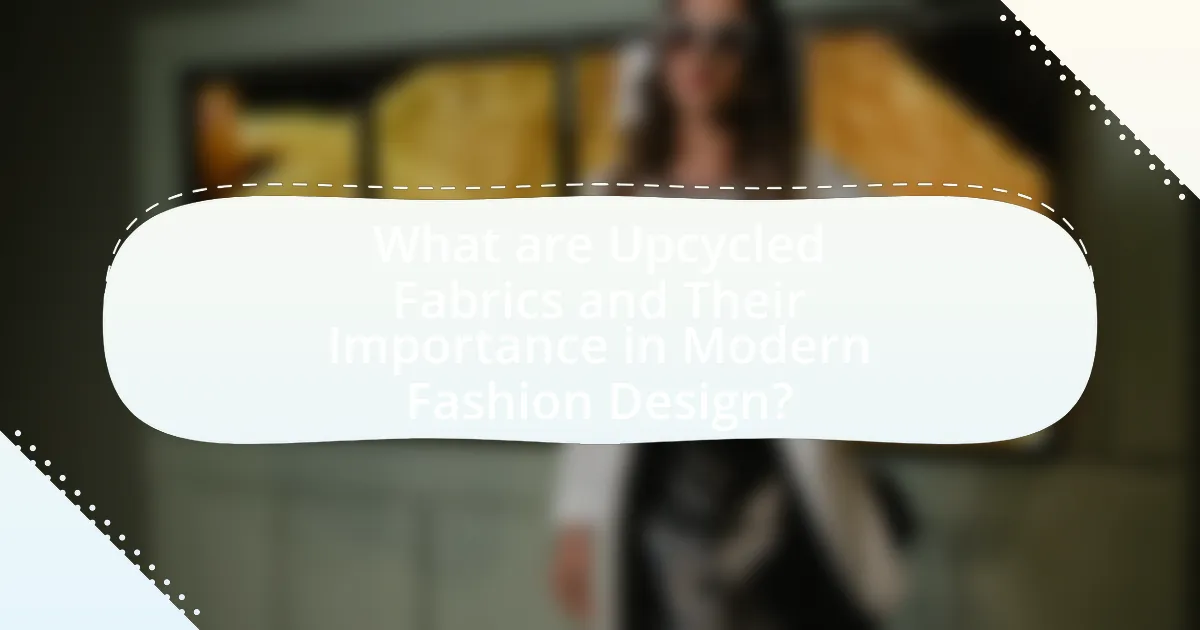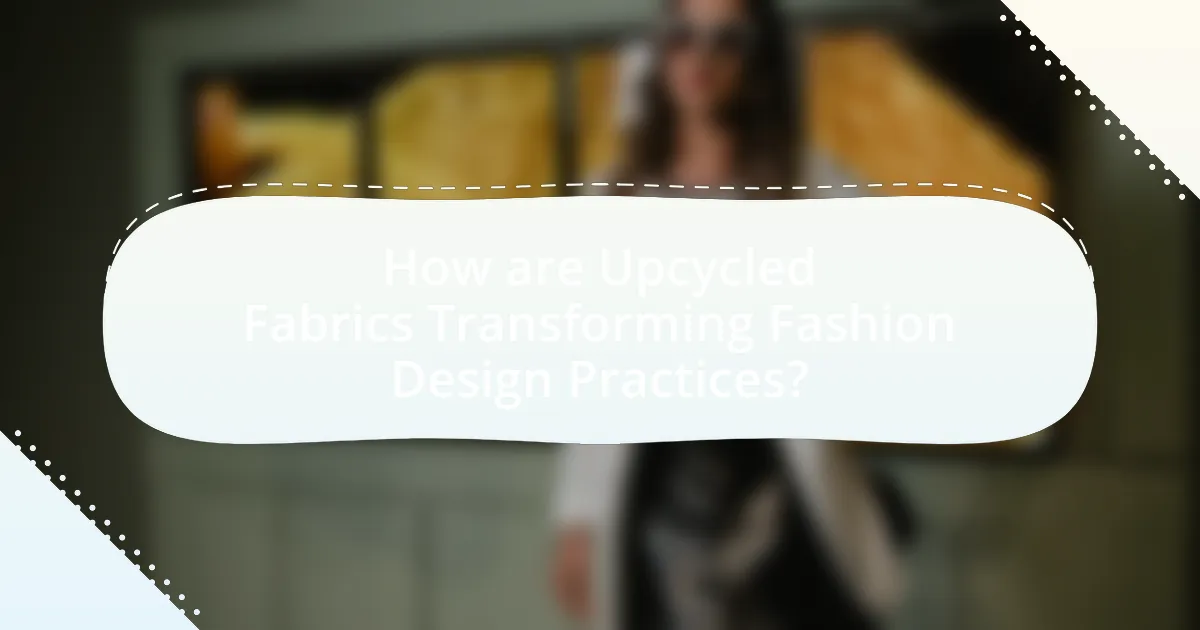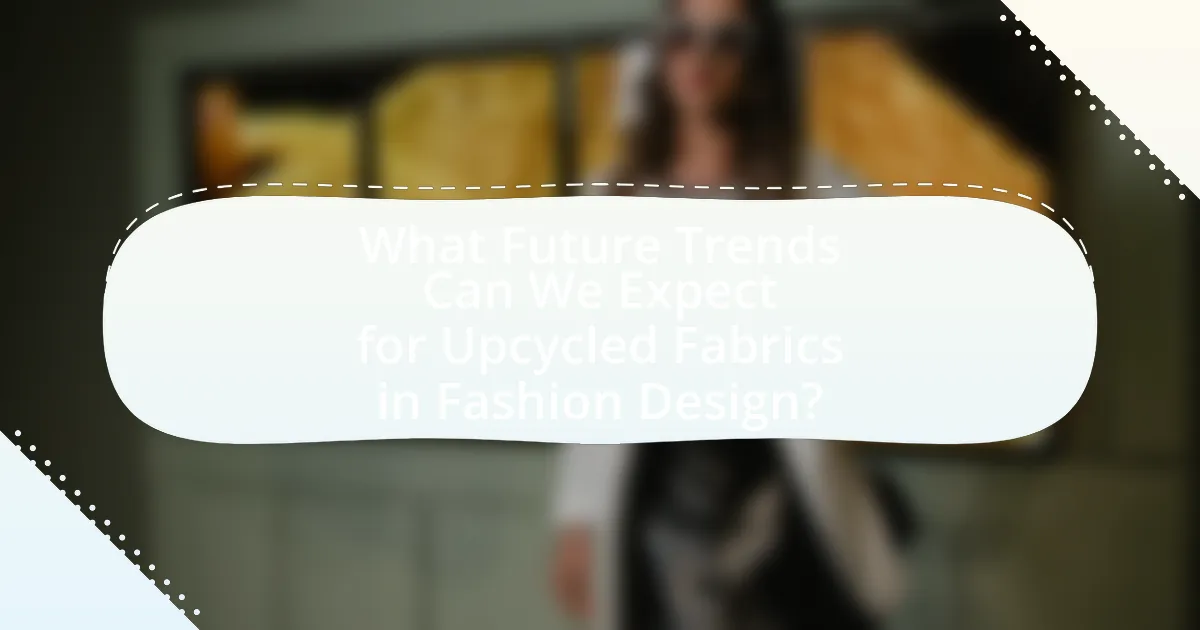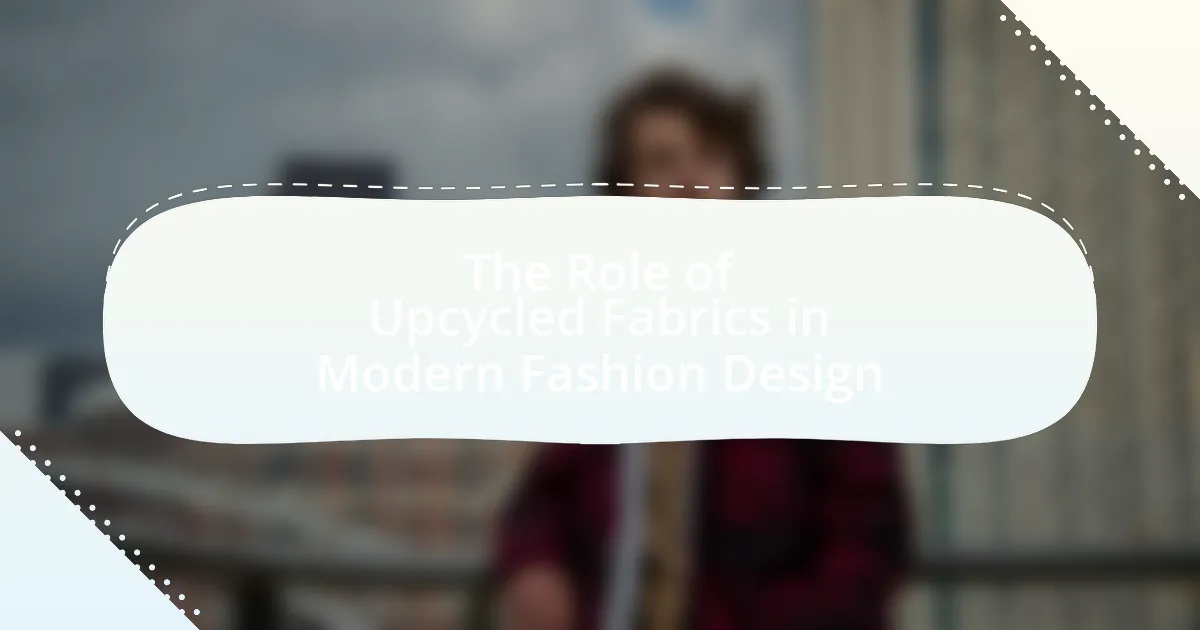Upcycled fabrics are materials repurposed from discarded textiles, playing a crucial role in modern fashion design by promoting sustainability and reducing waste. The article explores the definition of upcycled fabrics, the types of materials suitable for upcycling, and the differences between upcycling and recycling. It highlights the environmental benefits of using upcycled fabrics, the challenges designers face, and the innovative techniques employed in their integration into fashion collections. Additionally, the article discusses consumer perceptions, emerging trends in sustainable fashion, and the impact of technology on the upcycling process, providing a comprehensive overview of the significance of upcycled fabrics in the fashion industry.

What are Upcycled Fabrics and Their Importance in Modern Fashion Design?
Upcycled fabrics are materials that have been repurposed from discarded textiles or products, transforming them into new, usable items in fashion design. Their importance in modern fashion design lies in their ability to reduce waste, promote sustainability, and encourage creativity. According to the Ellen MacArthur Foundation, the fashion industry is responsible for significant environmental impacts, including the production of over 92 million tons of waste annually. By utilizing upcycled fabrics, designers can mitigate these effects, contributing to a circular economy and reducing the demand for new raw materials. This practice not only supports environmental sustainability but also fosters innovative design solutions, as creators often combine various materials and techniques to produce unique garments.
How are upcycled fabrics defined in the context of fashion?
Upcycled fabrics in the context of fashion are defined as materials that have been repurposed from discarded textiles or products to create new garments or accessories. This practice not only reduces waste but also promotes sustainability by extending the lifecycle of materials. According to a report by the Ellen MacArthur Foundation, the fashion industry is responsible for significant environmental impact, and upcycling offers a viable solution by transforming waste into valuable resources, thereby contributing to a circular economy.
What materials can be considered for upcycling in fashion design?
Upcycling in fashion design can consider materials such as discarded textiles, vintage clothing, surplus fabric, and even non-textile items like plastic bottles and old leather goods. Discarded textiles, which include off-cuts and damaged garments, provide a rich source for new designs, while vintage clothing can be repurposed to create unique pieces. Surplus fabric, often left over from manufacturing processes, can be utilized to minimize waste. Additionally, non-textile items like plastic bottles can be transformed into fibers for clothing, showcasing innovative approaches to sustainability in the fashion industry. This practice not only reduces waste but also promotes creativity and resourcefulness in design.
How does the process of upcycling differ from recycling?
Upcycling differs from recycling in that upcycling transforms waste materials into new products of higher value or quality, while recycling breaks down materials to create new raw materials. Upcycling often involves creative processes, such as redesigning or repurposing items, which can enhance their aesthetic or functional appeal. In contrast, recycling typically involves industrial processes that reduce materials to their base components, which may not retain the original item’s value or character. For example, upcycled fabrics in fashion design can be turned into unique garments, whereas recycled fabrics are often used to produce basic textiles.
Why is the use of upcycled fabrics gaining popularity in the fashion industry?
The use of upcycled fabrics is gaining popularity in the fashion industry due to increasing consumer demand for sustainable and environmentally friendly practices. This shift is driven by a growing awareness of the negative environmental impacts of fast fashion, which contributes to significant waste and pollution. According to a report by the Ellen MacArthur Foundation, the fashion industry is responsible for 92 million tons of waste annually, highlighting the urgent need for more sustainable alternatives. Upcycling not only reduces waste by repurposing existing materials but also promotes creativity and innovation in design, appealing to eco-conscious consumers. As a result, brands that incorporate upcycled fabrics are increasingly seen as responsible and forward-thinking, further enhancing their market appeal.
What environmental benefits do upcycled fabrics provide?
Upcycled fabrics provide significant environmental benefits by reducing waste and conserving resources. By repurposing materials that would otherwise end up in landfills, upcycled fabrics help minimize the environmental impact associated with textile production, which is responsible for approximately 10% of global carbon emissions. Additionally, using existing materials decreases the demand for new resources, such as water and energy, which are heavily consumed in traditional fabric manufacturing processes. This practice not only lowers pollution levels but also promotes a circular economy, where materials are reused and recycled, further enhancing sustainability in the fashion industry.
How do upcycled fabrics contribute to sustainable fashion practices?
Upcycled fabrics contribute to sustainable fashion practices by reducing waste and minimizing the demand for new resources. By repurposing discarded textiles, the fashion industry can significantly decrease the environmental impact associated with production processes, which often involve high water usage and carbon emissions. For instance, the Ellen MacArthur Foundation reports that upcycling can divert millions of tons of textile waste from landfills, thereby promoting a circular economy. This practice not only conserves raw materials but also encourages innovative design solutions, fostering a more sustainable approach to fashion.
What challenges do designers face when using upcycled fabrics?
Designers face several challenges when using upcycled fabrics, primarily related to material quality and consistency. The variability in the source materials can lead to difficulties in achieving uniformity in texture, color, and durability, which are crucial for creating cohesive collections. Additionally, the limited availability of specific types of upcycled fabrics can restrict designers’ creative options, making it harder to execute their visions. Furthermore, the need for additional processing to clean and prepare these materials can increase production time and costs, complicating the design process. These challenges highlight the complexities involved in integrating upcycled fabrics into modern fashion design.
How do quality and consistency issues affect the design process?
Quality and consistency issues significantly hinder the design process by leading to unpredictable outcomes and increased revisions. When designers work with upcycled fabrics, variations in material quality can result in inconsistent textures, colors, and durability, complicating the design intent. For instance, a study by the Ellen MacArthur Foundation highlights that inconsistent material properties can lead to higher waste rates, as designers may need to discard unusable pieces, ultimately affecting project timelines and budgets. This inconsistency can also compromise the overall aesthetic and functionality of the final product, making it challenging to achieve a cohesive design vision.
What are the limitations in sourcing upcycled materials?
The limitations in sourcing upcycled materials include inconsistent quality, limited availability, and potential contamination. Inconsistent quality arises because upcycled materials often come from various sources, leading to variations in durability and appearance. Limited availability is a challenge as the supply of suitable upcycled materials can fluctuate based on consumer behavior and waste generation patterns. Additionally, potential contamination from previous uses can pose risks, requiring thorough cleaning and processing to ensure safety and suitability for fashion applications. These factors collectively hinder the scalability and reliability of using upcycled materials in modern fashion design.

How are Upcycled Fabrics Transforming Fashion Design Practices?
Upcycled fabrics are transforming fashion design practices by promoting sustainability and encouraging innovative creativity. Designers are increasingly incorporating upcycled materials to reduce waste and environmental impact, with studies indicating that the fashion industry contributes approximately 10% of global carbon emissions. This shift not only fosters eco-friendly practices but also inspires unique design aesthetics, as upcycled fabrics often come with distinct textures and histories that enhance the storytelling aspect of fashion. Brands like Reformation and Patagonia exemplify this trend, showcasing how upcycled materials can lead to both stylish and responsible fashion choices.
What innovative techniques are being used with upcycled fabrics?
Innovative techniques used with upcycled fabrics include laser cutting, digital printing, and zero-waste pattern making. Laser cutting allows for precise designs and intricate patterns, enhancing the aesthetic appeal of upcycled materials. Digital printing enables the application of unique graphics and colors directly onto the fabric, transforming discarded textiles into fashionable items. Zero-waste pattern making focuses on creating garments that utilize the entire fabric, minimizing waste and promoting sustainability. These techniques not only elevate the design process but also contribute to environmental conservation by reducing textile waste in the fashion industry.
How do designers incorporate upcycled fabrics into their collections?
Designers incorporate upcycled fabrics into their collections by sourcing discarded textiles and repurposing them into new garments. This practice not only reduces waste but also promotes sustainability in fashion. For instance, brands like Reformation and Patagonia utilize surplus materials and vintage fabrics to create unique pieces, demonstrating a commitment to environmental responsibility. By integrating upcycled fabrics, designers can offer distinctive styles while addressing the growing consumer demand for eco-friendly fashion solutions.
What role does creativity play in the design of upcycled fashion items?
Creativity is essential in the design of upcycled fashion items as it transforms discarded materials into innovative and desirable products. Designers utilize creativity to envision new uses for old textiles, allowing them to reimagine and reconstruct garments that reflect contemporary aesthetics while promoting sustainability. For instance, a study published in the Journal of Fashion Technology & Textile Engineering highlights that creative approaches in upcycling can lead to unique fashion statements, reducing waste and encouraging eco-conscious consumer behavior. This demonstrates that creativity not only enhances the visual appeal of upcycled items but also plays a critical role in addressing environmental issues within the fashion industry.
How do consumer perceptions influence the use of upcycled fabrics?
Consumer perceptions significantly influence the use of upcycled fabrics by driving demand for sustainable fashion choices. As awareness of environmental issues grows, consumers increasingly favor brands that prioritize eco-friendly practices, including the use of upcycled materials. Research indicates that 66% of global consumers are willing to pay more for sustainable brands, highlighting a shift in purchasing behavior towards products that reflect environmental consciousness. This shift encourages designers to incorporate upcycled fabrics into their collections, as positive consumer perception can enhance brand loyalty and market competitiveness.
What trends are emerging in consumer demand for sustainable fashion?
Emerging trends in consumer demand for sustainable fashion include a significant shift towards upcycled materials, increased transparency in supply chains, and a preference for brands that prioritize ethical practices. Consumers are increasingly seeking clothing made from upcycled fabrics, which reduces waste and promotes circular fashion. According to a 2022 survey by McKinsey & Company, 67% of consumers consider sustainability when making a purchase, indicating a growing awareness and demand for environmentally friendly options. Additionally, brands that provide clear information about their sourcing and production processes are gaining favor, as consumers desire to support companies that align with their values. This trend reflects a broader movement towards responsible consumption and a commitment to reducing the fashion industry’s environmental impact.
How can brands effectively market upcycled fashion products?
Brands can effectively market upcycled fashion products by emphasizing sustainability, storytelling, and unique design. Highlighting the environmental benefits of upcycling, such as reducing waste and conserving resources, resonates with eco-conscious consumers. For instance, a study by McKinsey & Company found that 67% of consumers consider sustainability when making a purchase. Additionally, brands should share the story behind each product, detailing the materials used and the creative process involved, which can create an emotional connection with customers. Unique designs that showcase the individuality of upcycled items can also attract consumers looking for one-of-a-kind pieces. By combining these strategies, brands can enhance their appeal and drive sales in the upcycled fashion market.

What Future Trends Can We Expect for Upcycled Fabrics in Fashion Design?
Future trends for upcycled fabrics in fashion design include increased integration of technology, greater consumer demand for sustainability, and innovative design techniques. The fashion industry is increasingly adopting digital tools, such as 3D printing and AI, to create unique upcycled pieces, enhancing creativity while minimizing waste. According to a report by McKinsey & Company, 67% of consumers consider sustainability when making a purchase, indicating a strong market shift towards eco-friendly practices. Additionally, designers are exploring new methods of upcycling, such as combining different fabric types and employing zero-waste patterns, which further supports the trend of sustainable fashion.
How might technology impact the upcycling process in fashion?
Technology significantly enhances the upcycling process in fashion by enabling innovative design techniques and efficient material processing. Advanced software tools allow designers to visualize and manipulate existing garments digitally, facilitating creative transformations that maintain the original fabric’s integrity. Additionally, technologies such as 3D printing and laser cutting streamline the production of upcycled items, reducing waste and time. For instance, a study by the Ellen MacArthur Foundation highlights that digital tools can optimize material usage, potentially decreasing fabric waste by up to 30%. Furthermore, blockchain technology can improve transparency in sourcing upcycled materials, ensuring ethical practices and fostering consumer trust.
What advancements in textile technology could enhance upcycling?
Advancements in textile technology that could enhance upcycling include the development of biodegradable fabrics, advanced recycling techniques, and digital printing technologies. Biodegradable fabrics, such as those made from organic cotton or hemp, allow for easier decomposition at the end of their life cycle, reducing waste. Advanced recycling techniques, like chemical recycling, enable the breakdown of textiles into their original fibers, which can then be reused to create new fabrics, significantly increasing the potential for upcycling. Digital printing technologies allow for precise designs to be applied to upcycled materials, enhancing their aesthetic appeal and marketability. These advancements collectively contribute to a more sustainable fashion industry by maximizing the utility of existing materials and minimizing environmental impact.
How can digital platforms support the upcycled fashion movement?
Digital platforms can support the upcycled fashion movement by providing marketplaces for upcycled products, facilitating community engagement, and promoting educational content about sustainable practices. These platforms enable designers and consumers to connect, allowing for the sale and purchase of upcycled items, which can increase visibility and sales for small businesses. For instance, platforms like Etsy and Depop have successfully created spaces where upcycled fashion can thrive, showcasing unique pieces that appeal to environmentally conscious consumers. Additionally, social media channels like Instagram and TikTok allow brands to share their stories and processes, raising awareness about the benefits of upcycling and encouraging more sustainable consumer behavior. Research indicates that 66% of consumers are willing to pay more for sustainable brands, highlighting the potential market for upcycled fashion supported by digital platforms.
What best practices should designers follow when working with upcycled fabrics?
Designers should prioritize quality assessment, creative sourcing, and sustainable practices when working with upcycled fabrics. Quality assessment involves thoroughly inspecting the fabric for durability and cleanliness to ensure it meets design standards. Creative sourcing encourages designers to explore diverse materials, such as discarded garments or industrial waste, which can lead to unique and innovative designs. Sustainable practices include minimizing waste during the design process and considering the environmental impact of any additional materials used. According to a study by the Ellen MacArthur Foundation, upcycling can significantly reduce textile waste, making these practices not only beneficial for design but also for the environment.
How can designers ensure quality and sustainability in their upcycled collections?
Designers can ensure quality and sustainability in their upcycled collections by selecting high-quality materials, implementing rigorous quality control processes, and adopting eco-friendly production methods. High-quality materials, such as durable fabrics and components, enhance the longevity of the final product, while quality control processes, including thorough inspections and testing, help maintain standards. Additionally, using eco-friendly production methods, such as low-impact dyes and energy-efficient techniques, minimizes environmental impact. Research indicates that sustainable practices in fashion can reduce carbon emissions by up to 30%, reinforcing the importance of these strategies in upcycled collections.
What resources are available for designers interested in upcycling?
Designers interested in upcycling can access a variety of resources including online platforms, workshops, and community initiatives. Websites like Upcycle That and The Upcycle Movement provide guides, tutorials, and inspiration for upcycling projects. Additionally, organizations such as the Ellen MacArthur Foundation offer research and case studies on circular fashion, emphasizing the importance of upcycling in sustainable design. Local workshops and maker spaces often host events focused on upcycling techniques, allowing designers to gain hands-on experience and network with like-minded individuals. These resources collectively support designers in integrating upcycled materials into their work, promoting sustainability in fashion design.

Leave a Reply